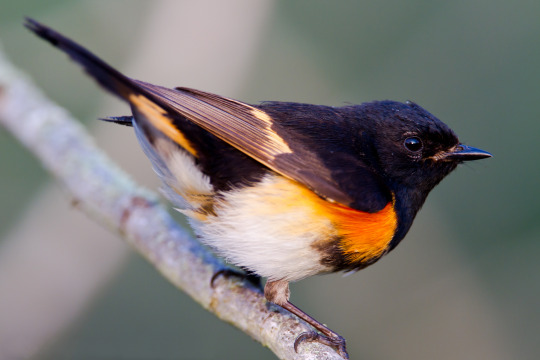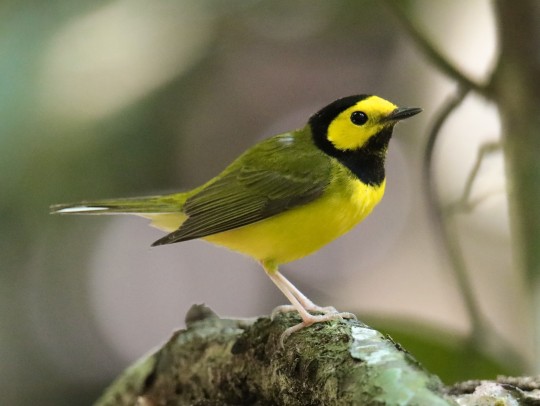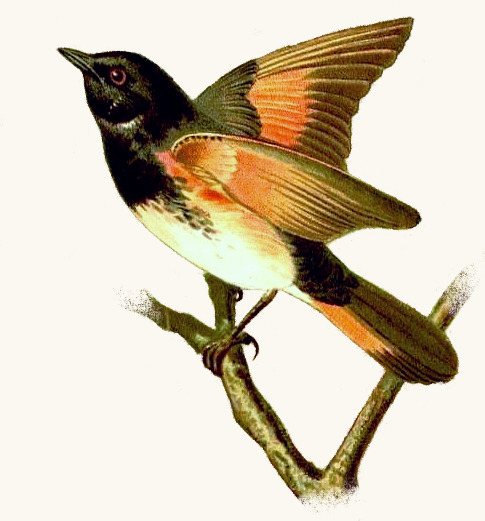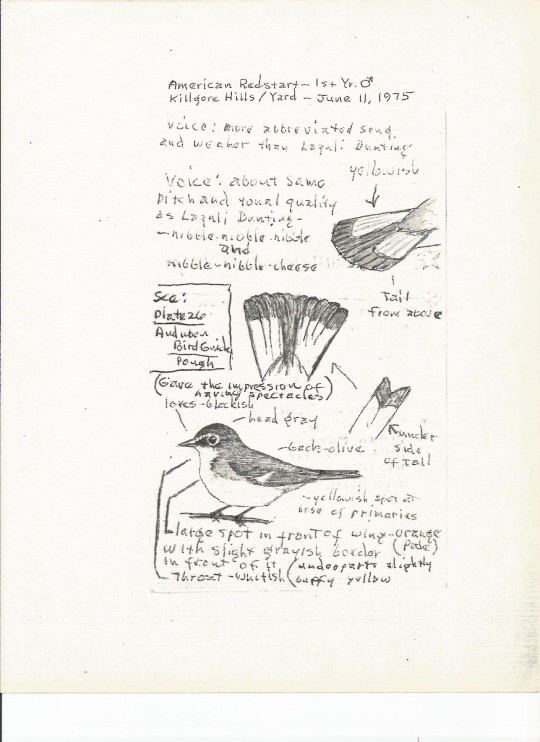#Setophaga ruticilla
Explore tagged Tumblr posts
Text

Geothlypis trichas | Setophaga caerulescens | Geothlypis formosa | Setophaga citrina | Setophaga ruticilla | Seiurus aurocapilla
Plate XIV | Die Nordamerikanische Vogelwelt (1891)
#bird art#bird illustration#vintage art#vintage illustration#artists on tumblr#parulidae#new world warblers#geothlypis trichas#common yellowthroat#setophaga caerulescens#black throated blue warbler#geothlypis formosa#kentucky warbler#setophaga citrina#hooded warbler#setophaga ruticilla#american redstart#seiurus aurocapilla#ovenbird#gustav mützel
237 notes
·
View notes
Text



#poll#Class: Aves#Order: Passeriformes#Family: Parulidae#Genus: Setophaga#Setophaga Ruticilla#Range: Nearctic#Range: Neotropical
105 notes
·
View notes
Text
BOTD: American Redstart

Photo: Doug Greenberg
"Warblers in general are often called 'the butterflies of the bird world,' but the Redstart may live up to that nickname more than any other species. This beautiful warbler flits about very actively in the trees, usually holding its wings and tail partly spread, as if to show off their patches of color. At times it feeds more like a flycatcher than a typical warbler, hovering among the foliage and often flying out to grab insects in mid-air."
- Audubon Field Guide
#birds#american redstart#birds of north america#north american birds#redstarts#warblers#wood warblers#passerines#birds of the us#birds of canada#birds of mexico#birds of central america#birding#bird watching#birdblr#birblr#bird of the day#Setophaga ruticilla
111 notes
·
View notes
Photo

American Redstart (Setophaga ruticilla)
© Neo Morpheus
82 notes
·
View notes
Text

american redstart (Setophaga ruticilla) by Judd Patterson
0 notes
Text
Genus: Setophaga

Originally, this genus was only used for the American Redstart (Setophaga ruticilla). Meaning 'moth-eater', it was used to refer to the flycatcher-like habits of the American Restart, which sallies forth from a perch to catch flying insects rather than plucking them from vegetation.
In 2010, however, a newly published paper disrupted what was thought of Parulidae taxonomy. Using a comprehensive molecular phylogenetic analysis of the family, several genus were merged into Setophaga. Not only that, but a separate genus of warbler was cleaved in two based on the findings.

The Hooded Warbler was previously listed under the genus Wilsonia along with Wilson's Warbler and Canada Warbler. They had even been in an obsolete genus together before this (Sylvania), though this was changed to Wilsonia for other reasons. The 2010 study showed that Wilsonia was polyphyletic, meaning the group may share similar traits, but do not share a common ancestor. Hooded Warbler was moved to Setophaga and Wilson's and Canada Warbler were placed into Cardellina, an existing genus with Red-faced, Pink-headed, and Red Warbler.

The two Parula species were also folded into Setophaga as a result of the 2010 study. The Northern and Tropical Parula were originally the only two members of this genus, with the Northern Parula being the type-specimen of New World Warblers as a whole. I find that a bit ironic, as they are one of the smallest warblers and show quite an unusual color patter when compared to the rest of Parulidae, but I don't exactly know how type-specimen are chosen.

The largest genus to be merged with Setophaga was Dendroica. When I first began learning species names, I was familiar with this as the genus for most warblers. Due to the way taxonomic names work, the name which was published first takes precedent in these merging scenarios. So, despite the fact Dendroica had around 30 species and Setophaga had just 1, Setophaga was published first in 1827 (Dendroica in 1842).
In summary, Setophaga went from just a single species to now being the largest in the Parulid family, holding 34 species!
Image Sources: AMRE (Dan Pancamo); HOWA (Ninahale); NOPA (Dan Pancamo); MAWA (Cephas)
#setophaga#parulidae#passeriformes#bird#north american birds#american birds#american redstart#hooded warbler#northern parula#magnolia warbler#(had to include MAWA in there they're babyyyy)#(also hi I'm wikipedia now I guess. linking to other wiki pages within my own article like damn lol)#Genus Feature
69 notes
·
View notes
Text





[ID: Five photos of a juvenile male American redstart (setophaga ruticilla) in the middle of a molt. In the first three photos, it's facing the viewer, and in the last two it is facing away. Its feathers are messy and awkward, fluffed up in some places and showing bare skin in others. End ID]
Another highlight from my outing today! American redstart in his awkward teen phase
#birds#birding#american redstart#photography#wildlife photography#animals#my photos#hes so funny looking#loving the awkward teen phase
9 notes
·
View notes
Text
i identified the birds for anyone who is curious :)
Cyanocitta cristata, Southeastern Blue Jay
Icterus galbula, Baltimore Oriole
Tachycineta bicolor, Tree Swallow
Setophaga ruticilla, American Redstart (almost confused this for the I. galbula again)
Icterus spurius, Orchard Oriole
Archilochus colubris, Ruby-Throated Hummingbird
Mniotilta varia, Black-and-White Warbler
Vermivora cyanoptera, Blue-Winged Warbler (i think)
Pheucticus ludovicianus, Rose-Breasted Grosbeak
Passerina cyanea, Indigo Bunting
Setophaga petechia, Yellow Warbler
Bombycilla cedrorum, Cedar Waxwing
Cardinalis cardinalis, Northern Cardinal
Cute birds appreciation post
84K notes
·
View notes
Quote
渡り鳥は旅をしながら他の種と会話し、情報交換をしている可能性 著者パルモ 公開:2025-01-19・更新:2025-01-19 定期的に長距離を移動する渡り鳥だが、飛行の旅を続けながら他の種の鳥たちと「会話」をしているかもしれない、という面白い研究結果が発表された。 これまで渡り鳥は、本能的に集団をつくり、記憶したルートを移動していると考えられてきた。 広告の下に記事が続いています だが、イリノイ大学の新たな研究では、渡り鳥は他種の鳥と、情報交換しながら移動することで、渡りの成功率を上げている可能性があるという。 渡り鳥が飛行中に発する鳴き声を調査 米イリノイ大学アーバナ・シャンペーン校の自然資源・環境科学部のベンジャミン・ヴァン・ドーレン氏率いる研究チームが注目したのは、渡り鳥が夜に発する短い鳴き声だ。 これらの鳴き声は、何か特別な意味があるかもしれない。例えば声を使ってお互いの存在を知らせたり、情報交換をしている可能性がある。 そこで研究チームは、東アメリカの26か所で3年間にわたって、夜間に渡り鳥たちが発する鳴き声を記録した。 記録されたデータは合計18,300時間以上に及ぶ膨大な量だ。このデータを分析するため、研究チームはAIを使い、27種類の鳥の鳴き声を特定、その中には25種の鳴禽類(スズメ亜目)が含まれていた。 研究チームは、15秒、30秒、60秒という時間間隔で異なる種の鳴き声が同時に録音される頻度を測定した。 その結果、偶然では説明できないほど違う種類の鳥同士が一緒に鳴いていることがわかった。 これは、渡りの最中に異種間での社会的つながりが形成されている可能性を示唆している。 興味深いことに、翼の長さや飛行速度が似ている種同士でこの傾向が強く、また、声の特徴が類似している種も同様に結びつきやすいことが分かった。 ドーレン氏は、「翼の大きさが似ている種は同じ速度で飛ぶ可能性が高く、一緒に移動しやすい」と説明している。 また、声については、もしかしたら似た鳴き声を持つ鳥たちが、時間をかけて社会的に結びついてきたのかもしれないという。 この画像を大きなサイズで見る 渡りをする小型のウグイス科の鳥、Redstart streaks(Setophaga ruticilla) image credit:Andrew Dreelin 渡り鳥の社会的つながり 2024年7月の研究では、北東アメリカでの渡りの途中、異なる種が「仲間」として休息地を共有することが確認されていた。 今回の研究では、この異種間の社会的つながりは飛行中にも行われていることを示唆している。 野生の鳴禽類は短命で、その寿命は個体差もあるが2~3年程度と言われている。 命の短い鳴禽類は親からルートを教わる時間が少ない。だから、こうして、他の鳥たちとのつながりをもって、正しい渡りのルートや休憩場所を教わっている可能性が高いと、研究チームは考えている。 またドーレン氏は、「気候変動や生息地の減少が、共に移動する鳥たちの繋がりにどのような影響を与えるかを理解することが重要だ」と述べている。 この画像を大きなサイズで見る Photo by:iStock 新しい技術で渡り鳥の「会話」を追跡 今後、研究チームは渡り鳥に最新の小型マイクを装着し、渡りの間に鳥たちが交わす「会話」を追跡する計画を立てている。 これにより、渡り鳥の社会的な行動や、こうした行動がどのように進化してきたのかをより深く理解できると期待されている。 この研究は、変化する環境の中で鳥類を守るための重要な手がかりになるだろう。 空の上で種の違った鳥たちが、「調子はどう?あっちに言い休憩所あるぜ」とか、「こっちのルートの方が近道だよ」とか話し合っているところを想像すると心が和むなー。 この研究は『Current Biology』誌(2025年1月15日付)に掲載された。 References: Cell.com / Songbirds socialize on the wing during migrat | EurekAlert! 広告の下にスタッフが選んだ「あわせて読みたい」が続きます あわせて読みたい カッコウの托卵が、新種を次々と生み出す理由 「幸せの青い鳥」イソヒヨドリが、アメリカで初めて目撃される 渡り鳥のために電気を消そう!テキサス州の夜間消灯キャンペーン オスのキンカチョウは一日に何時間も発声練習することで声帯の筋トレを行っている 北海道・沖縄間を3往復分、13,560 kmを11日間飛び続けた渡り鳥がギネス世界記録を更新
渡り鳥は旅をしながら他の種と会話し、情報交換をしている可能性 | カラパイア
0 notes
Text
Migratory Birds Sing in Friendship with Other Species
January 15, 2025 3 min read Migratory Birds Sing in Friendship with Other Species Songbirds across species tend to socialize during night migrations By Gayoung Lee edited by Sarah Lewin Frasier An American Redstart song (Setophaga ruticilla). Brian Reinke/Getty Images Small songbirds like cardinals and terns migrate thousands of miles, flying at night and resting during the day, to and from…
0 notes
Photo

American Redstart (Setophaga ruticilla) 05/10/2023 - 05/13/2023 NY & VT US #americanredstart #redstart #bestbackroad #bestbackroads #natgeoyourshots #natgeo100contest #natgeo #rutlandcountyvt #washingtoncountyny #whitehallny #wildphotography #naturephotography #adventurephotography #wildlifephotography — view on Instagram https://ift.tt/igQWDtT
0 notes
Photo

American Redstart
1K notes
·
View notes
Text



Geothlypis formosa Kentukcy warbler
Setophaga citrina Hooded warbler
Setophaga ruticilla American redstart
Gustav Mützel, Die Nordamerikanische Vogelwelt, via Flickr
#kentucky warbler#hooded warbler#american redstart#gustav mutzel#public domain#passerines#aves#illustration#parulidae#geothlypis formosa#geothlypis#setophaga#setophaga ruticilla#setophaga citrina
22 notes
·
View notes
Text

American redstart, Setophaga ruticilla. Brings my birthday week bird species count to 59, somewhat short of my goal. But I was glad to see this fellow a half hour ago on my walk. Redstarts are one of my favorites among the spring warblers.
132 notes
·
View notes
Photo

American Redstart (Setophaga ruticilla)
© Thomas Sherry
8 notes
·
View notes
Photo

American Redstart (Setophaga ruticilla)
© Ray Ekstrom
3 notes
·
View notes